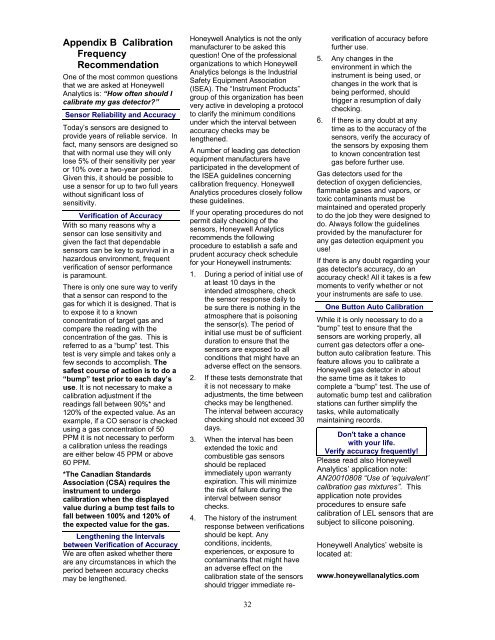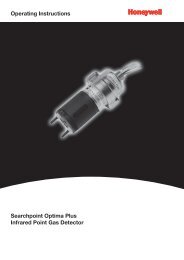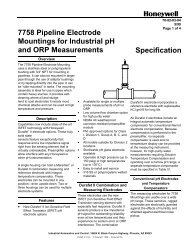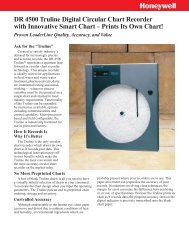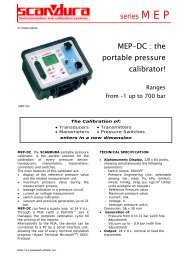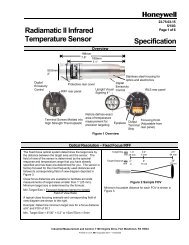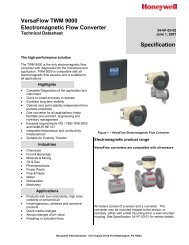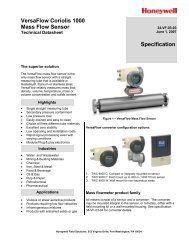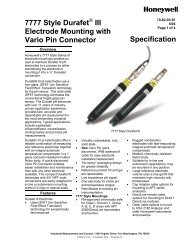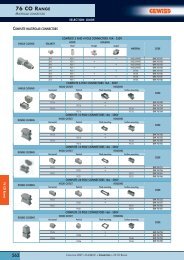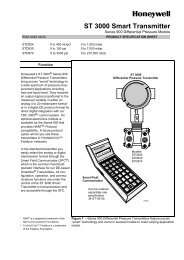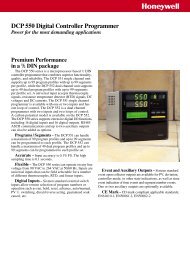PhD6 Multi-Gas Detector Reference Manual - Honeywell Analytics
PhD6 Multi-Gas Detector Reference Manual - Honeywell Analytics
PhD6 Multi-Gas Detector Reference Manual - Honeywell Analytics
Create successful ePaper yourself
Turn your PDF publications into a flip-book with our unique Google optimized e-Paper software.
Appendix B CalibrationFrequencyRecommendationOne of the most common questionsthat we are asked at <strong>Honeywell</strong><strong>Analytics</strong> is: “How often should Icalibrate my gas detector?”Sensor Reliability and AccuracyToday’s sensors are designed toprovide years of reliable service. Infact, many sensors are designed sothat with normal use they will onlylose 5% of their sensitivity per yearor 10% over a two-year period.Given this, it should be possible touse a sensor for up to two full yearswithout significant loss ofsensitivity.Verification of AccuracyWith so many reasons why asensor can lose sensitivity andgiven the fact that dependablesensors can be key to survival in ahazardous environment, frequentverification of sensor performanceis paramount.There is only one sure way to verifythat a sensor can respond to thegas for which it is designed. That isto expose it to a knownconcentration of target gas andcompare the reading with theconcentration of the gas. This isreferred to as a “bump” test. Thistest is very simple and takes only afew seconds to accomplish. Thesafest course of action is to do a“bump” test prior to each day’suse. It is not necessary to make acalibration adjustment if thereadings fall between 90%* and120% of the expected value. As anexample, if a CO sensor is checkedusing a gas concentration of 50PPM it is not necessary to performa calibration unless the readingsare either below 45 PPM or above60 PPM.*The Canadian StandardsAssociation (CSA) requires theinstrument to undergocalibration when the displayedvalue during a bump test fails tofall between 100% and 120% ofthe expected value for the gas.Lengthening the Intervalsbetween Verification of AccuracyWe are often asked whether thereare any circumstances in which theperiod between accuracy checksmay be lengthened.32<strong>Honeywell</strong> <strong>Analytics</strong> is not the onlymanufacturer to be asked thisquestion! One of the professionalorganizations to which <strong>Honeywell</strong><strong>Analytics</strong> belongs is the IndustrialSafety Equipment Association(ISEA). The “Instrument Products”group of this organization has beenvery active in developing a protocolto clarify the minimum conditionsunder which the interval betweenaccuracy checks may belengthened.A number of leading gas detectionequipment manufacturers haveparticipated in the development ofthe ISEA guidelines concerningcalibration frequency. <strong>Honeywell</strong><strong>Analytics</strong> procedures closely followthese guidelines.If your operating procedures do notpermit daily checking of thesensors, <strong>Honeywell</strong> <strong>Analytics</strong>recommends the followingprocedure to establish a safe andprudent accuracy check schedulefor your <strong>Honeywell</strong> instruments:1. During a period of initial use ofat least 10 days in theintended atmosphere, checkthe sensor response daily tobe sure there is nothing in theatmosphere that is poisoningthe sensor(s). The period ofinitial use must be of sufficientduration to ensure that thesensors are exposed to allconditions that might have anadverse effect on the sensors.2. If these tests demonstrate thatit is not necessary to makeadjustments, the time betweenchecks may be lengthened.The interval between accuracychecking should not exceed 30days.3. When the interval has beenextended the toxic andcombustible gas sensorsshould be replacedimmediately upon warrantyexpiration. This will minimizethe risk of failure during theinterval between sensorchecks.4. The history of the instrumentresponse between verificationsshould be kept. Anyconditions, incidents,experiences, or exposure tocontaminants that might havean adverse effect on thecalibration state of the sensorsshould trigger immediate reverificationof accuracy beforefurther use.5. Any changes in theenvironment in which theinstrument is being used, orchanges in the work that isbeing performed, shouldtrigger a resumption of dailychecking.6. If there is any doubt at anytime as to the accuracy of thesensors, verify the accuracy ofthe sensors by exposing themto known concentration testgas before further use.<strong>Gas</strong> detectors used for thedetection of oxygen deficiencies,flammable gases and vapors, ortoxic contaminants must bemaintained and operated properlyto do the job they were designed todo. Always follow the guidelinesprovided by the manufacturer forany gas detection equipment youuse!If there is any doubt regarding yourgas detector's accuracy, do anaccuracy check! All it takes is a fewmoments to verify whether or notyour instruments are safe to use.One Button Auto CalibrationWhile it is only necessary to do a“bump” test to ensure that thesensors are working properly, allcurrent gas detectors offer a onebuttonauto calibration feature. Thisfeature allows you to calibrate a<strong>Honeywell</strong> gas detector in aboutthe same time as it takes tocomplete a “bump” test. The use ofautomatic bump test and calibrationstations can further simplify thetasks, while automaticallymaintaining records.Don't take a chancewith your life.Verify accuracy frequently!Please read also <strong>Honeywell</strong><strong>Analytics</strong>’ application note:AN20010808 “Use of ‘equivalent’calibration gas mixtures”. Thisapplication note providesprocedures to ensure safecalibration of LEL sensors that aresubject to silicone poisoning.<strong>Honeywell</strong> <strong>Analytics</strong>’ website islocated at:www.honeywellanalytics.com


